Many years ago, zoom lenses have constant maximum aperture. For example, 80-200mm F4.0 means the maximum aperture throughout the whole zoom range from 80mm to 200mm is the same F4.0. Nowadays, this is no more the cases. In fact, only professional zoom lenses are of this type. Most consumer type zoom lenses have a variable maximum aperture. For example, the on-camera lens is 7.85-32mm F2.6-5.1, which means in the widest zoom setting (i.e., 7.85mm) the maximum aperture is F2.6 while in the longest setting (i.e., 32mm) the maximum aperture is F5.1. This is about a 1 2/3 stop difference. Is this unusual? Not at all. Especially when Leica and Zeiss started to manufacture variable aperture zoom lens, it is going to be the trend.
So, what is wrong with this variable aperture design? Actually, nothing is wrong. When you zoom in (resp., out), you have a smaller (resp., larger) aperture and, consequently, the fastest available shutter speed becomes slower (resp., faster). However, this variable aperture feature does cause some problems when the aperture has to be controlled precisely. One of these situations is when using a flash. Since the guide number of a flash is equal to the product of flash-subject distance and aperture, if aperture changes when zooming, the flash-subject distance should also be changed. For example, suppose we use a flash of GN 100. Suppose initially we choose to use aperture F5.6 and place the flash 100/5.6=18 ft from the subjects. Then, to get a tighter shoot we zoom in which causes the aperture to change to F8.0. If we ignore this aperture and take a shot, it is likely that the result will be an under-exposed one. To maintain correct exposure, we need to reposition the flash at a distance of 100/8 = 12.5 ft.
To partially overcome the problems caused by the variable aperture feature, Coolpix 4500 can fix the aperture while the lens zooms. However, since the selected aperture may be too large or too small that is out of the range of the exposure control by the camera, Nikon suggests to use an aperture in the range of F5.0 and F7.0 if the fixed-aperture feature is being used. More precisely, the 4500 could maintain a constant aperture when zooming if the aperture being used is in the range of F5.0 and F7.0. Outside of this range, the 4500 will not guarantee well-exposed images.
Note that this fixed aperture feature can only be used in the program (P) mode, aperture-priority (A) mode, shutter-priority (S) mode and manual exposure (M) mode.
To activate or deactivate this fixed aperture feature, follow the procedure below:

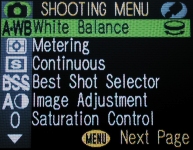
|

|
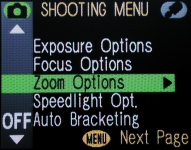
|
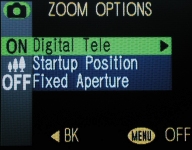
|
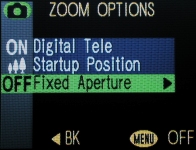
|
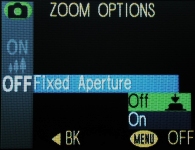
|
Note that once this option is chosen, it will stay there even after turning off the camera. Therefore, you need to go through the above procedure again to reverse the setting..